Feature
- VISIT YAMAGATA
- Feature
- [Feature] Bunshokan! Landmark architecture of an era of romance
[Feature] Bunshokan! Landmark architecture of an era of romance
- Yamagata
- 2022.08.06
Sightseeing・ Short trip
Classic Photos Family Solo Culture History Day trip
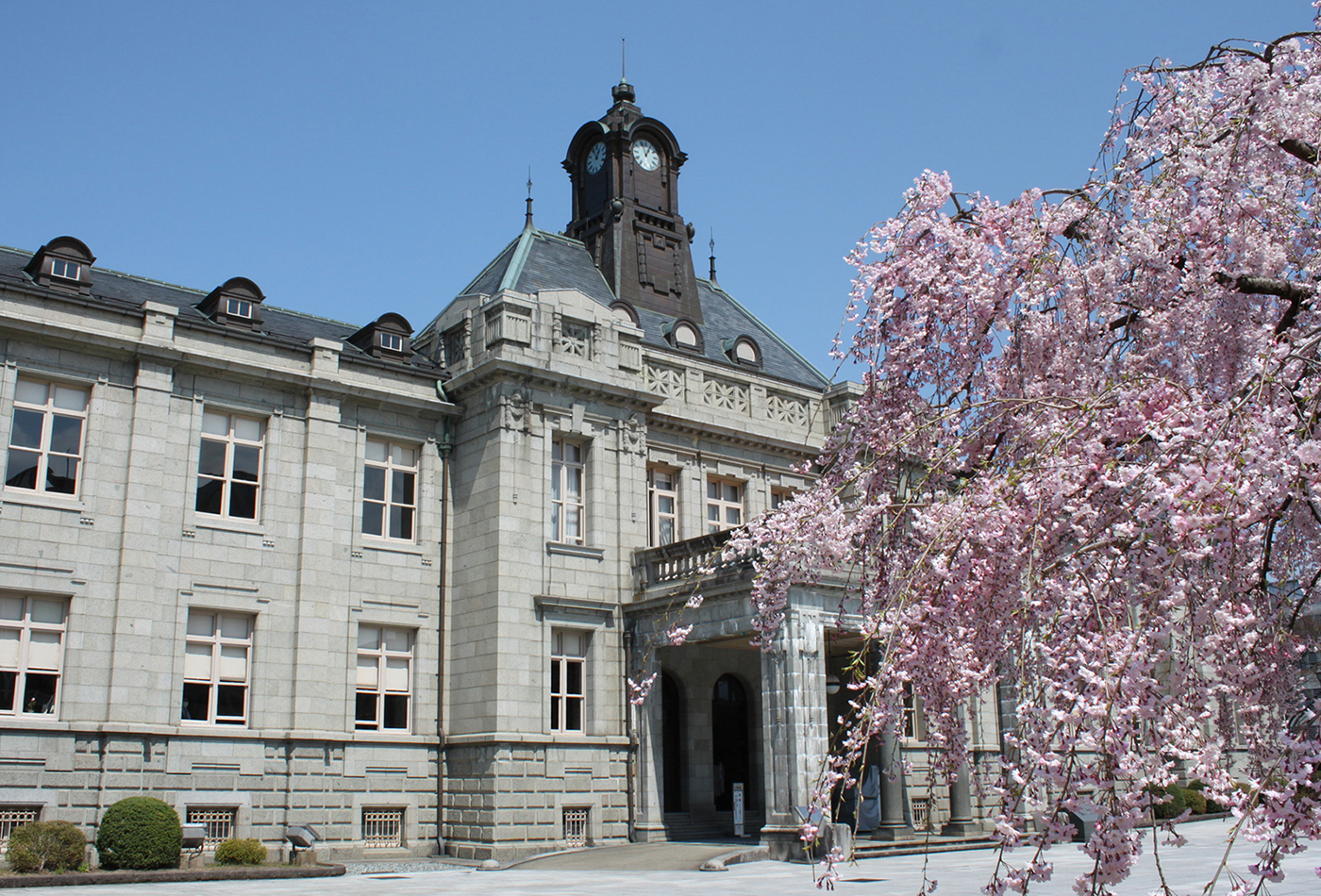
Yamagata City has many wonderful historical buildings.
Among them, the Bunshokan (old prefectural office) has a strong presence.
It can be reached in about 10 minutes by car from Yamagata Station.
In fact, the more you know, the more amazing the building is.
The building has charm due to a faithful restoration with original materials done by 500 craftsmen.
This impressive space has been chosen as the location of many movies as it has also elegant and luxurious furniture.
The clock tower is the second oldest one in operation in Japan and has ticked over 100 years.
There is also a café where you can enjoy sweets made with fruits from the prefecture.
The Bunshokan is open to the public and anyone can tour the inside for free and discover the history of Yamagata through its permanent exhibition.
Let’s look at the Bunshokan more in details!
1. Bunshokan (old prefectural office)
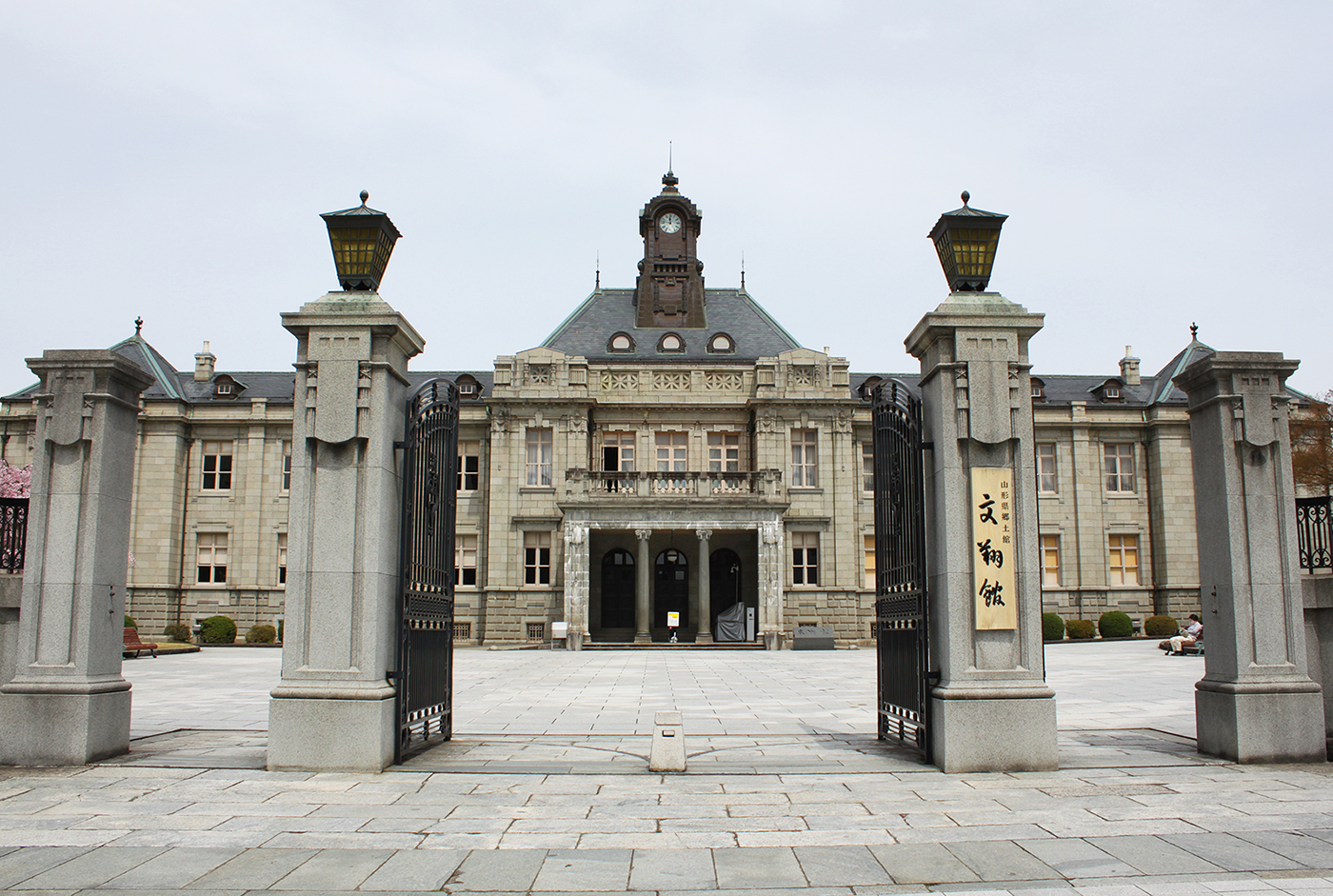
The Bunshokan was built in 1916 as the Yamagata Prefectural Government Building and the Prefectural Assembly Building.
The current official name is the “Yamagata Prefectural Folk Museum” but is nicknamed Bunshokan (old prefectural office).
The prefectural office was relocated to another location in 1975, but the former prefectural office and assembly building were preserved as they are valuable historical buildings of the early Taisho era. It was designated a National Important Cultural Property in 1984.
Currently, it is used as a facility to deepen the understanding of the citizens of the prefecture and to promote the culture of this prefecture.
2. Old prefectural office
① Fascinating stylistic beauty

Symbol of Yamagata City, the Bunshokan is a building of British-style architecture that is full of Taisho-era romance, diffusing a strong sense of the style of the time when it was built.
_202206_16.jpg)
From the gates to the exterior window frames and overhanging balconies to the striking central clock tower, the harmonious and symmetrical stylistic beauty is truly exquisite.
_202206_06.jpg)
The three-story building with a semi-underground floor is built as a square with an inner courtyard.
The outer walls are covered with granite that gives it a profound appearance.
The stones are said to have been mined at the Kamanohata district of the former Nakagawa Village, now Nanyo City.
_202206_05.jpg)
Seen from the front, it looks like a stone building, but it’s actually made of bricks.
_202206_17.jpg)
If you go to the courtyard surrounded by brick walls, you will feel like you are in a different building.
_202206_31-1.jpg)
It is connected to the old prefectural assembly building on the north side by a corridor that has a characteristic appearance.
_202206_31.jpg)
② Luxurious decoration and gorgeous furniture
Let’s finally get inside!
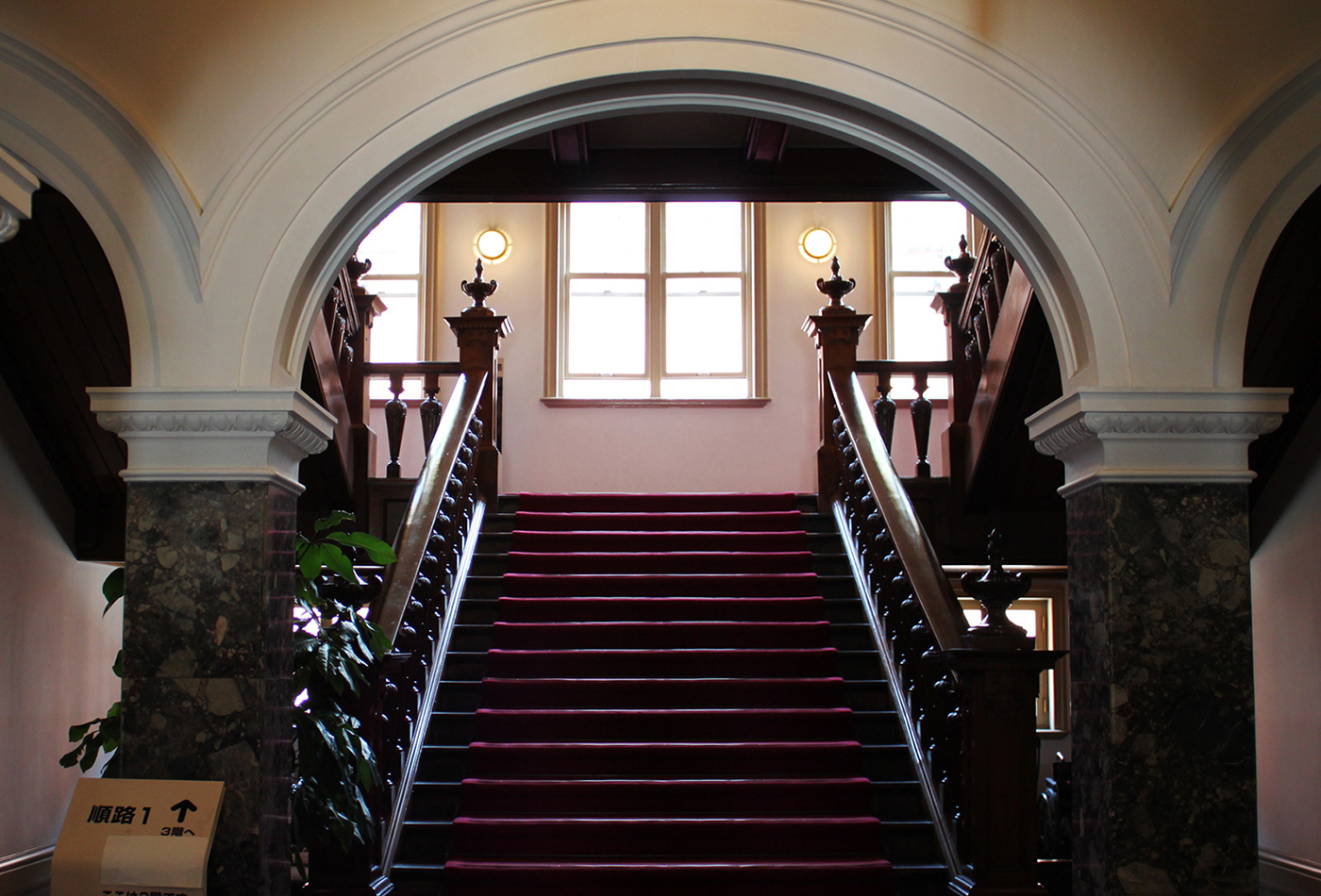
Immediately after entering from the entrance, the large staircase with a beautiful arch in front is impressive.
_202206_12.jpg)
There is stained glass with a laurel leaf ring decoration on the landing of the stairs.
It is all enchanted by modern design.
_202206_11.jpg)
_202206_13.jpg)
The handrails on the stairs have a solid feel that gives a profound feeling.
_202206_22.jpg)
Immediately after climbing the stairs is a room called “Shokan.”
It is said that this room was used for issuing resignations and important meetings when it was the prefectural office.
The furniture such as large tables and chairs, and the ceiling are elegant.
_202206_15.jpg)
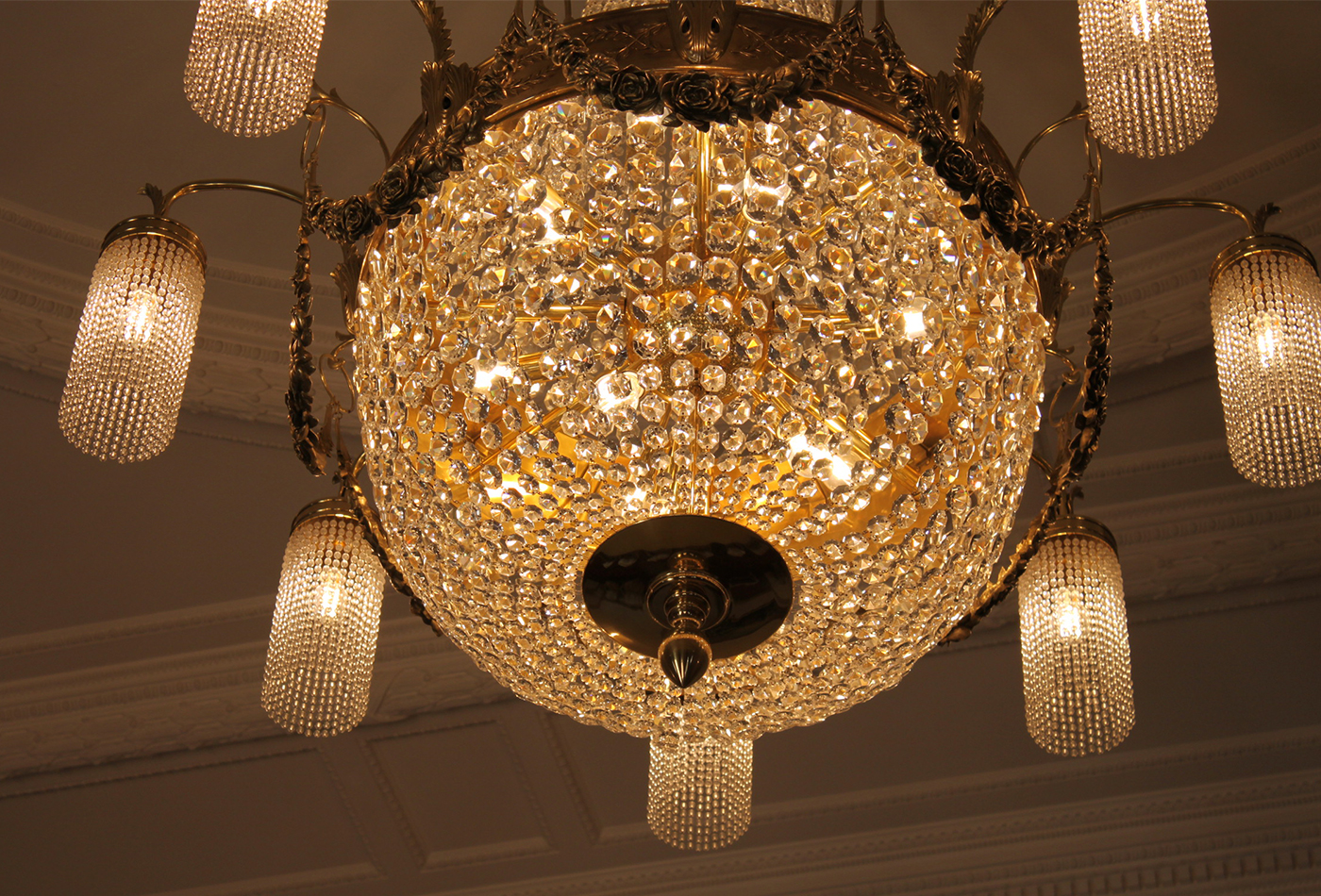
The chandelier shining on the high ceiling is also elegant.
The plaster decoration on the ceiling is very elaborate and beautiful!
_202206_32.jpg)
The room connects to an outdoor balcony.
_202206_24.jpg)
From the balcony, you can see the Nanokamachi street of downtown Yamagata City.
I went around the many rooms such as the Guest Room, the Vice Governor’s Office, the Governor’s Office, the Higher Government Dining Room, etc., andall the rooms are really luxurious in terms of construction and furnishings!
_202206_33.jpg)
VIP room
_202206_34.jpg)
_202206_35.jpg)
_202206_26.jpg)
The corridors where gentle light shines through the windows are beautifully lined with arches.
There is plenty of atmosphere in the corridor leading to the old prefectural building.
_202206_36.jpg)
The hall of the former prefectural assembly building had a high ceiling, creating a majestic atmosphere.
_202206_37.jpg)
The ceiling is a vault-shaped ceiling, and the floor is linoleum (a building material made from the natural ingredients of cork and flaxseed oil).
_202206_38.jpg)
It seems that this hall has been used as a venue for lectures and concerts since that time, and events such as concerts and plays are still held here.
③ Restoration work where craftsmanship shines
The Bunshokan was built in 1916.
While it was actually used as a prefectural office, it was expanded a few times but the building was remodeled during the war when required metal was stripped off.
The current Bunshokan is a beautiful building that doesn’t show that, and it is hard to think that it was built more than 100 years ago.
_202206_39.jpg)
The reason for that was the repair work that took 10 years (!) starting from 1986.
The materials used during its restoration were, as much as possible, the same ones as at the time of its construction, and it was thoroughly restored with the same construction methods!
_202206_79.jpg)
About 60 contractors and 500 craftsmen were involved in the renovations.
Today, as the number of skilled craftsmen has decreased, it may not have been possible to restore it anymore.
It seems that 80% of the craftsmen were craftsmen in Yamagata prefecture.
Although it is an old video, you can see the state at the time of restoration on YouTube.
Repair Video (YouTube)The video is also broadcast all day in the video hall (former police department) of Bunshokan, so please take a look when you come!
_202206_45.jpg)
In the County Mayor’s Waiting Room on the 3rd floor, records of restoration work and building materials at that time are displayed, and you can learn about the situation at that time.
The plaster ceiling decoration is also one of the restored sections.
_202206_42.jpg)
It seems that the plaster was removed from the ceiling to make it easier to extinguish the fire even in the event of an air raid during the war, but it was later restored based on the fragments found from the ceiling and the materials at that time.
It seems that the petals of each of these three-dimensional flowers are also made by hand…
It’s too amazing!
_202206_44.jpg)
At the time of restoration, the plaster decoration was filled with the playfulness of the craftsmen using Yamagata prefecture’s official flower, the safflower, and its official tree, the cherry tree.
Please look for them in the patterns ♪
_202206_47.jpg)
The beautiful chandeliers on the ceiling of each room have also been restored.
It seems that they are all using different designs, and not one is the same as the other!
The glass parts (Yoraku) used for the chandeliers were also polished one by one at the time of restoration…
That’s why it’s so glittering.
_202206_48.jpg)
In addition, many other parts have been restored, such as the red and yellow checkered pattern on the balcony, the linoleum on the floor, the slate roofing on the roof, and the copper plate roofing on the clock tower.
④ Clock tower that keeps time for over 100 years
_202206_53.jpg)
The symbolic clock tower of the Bunshokan is said to be the second oldest operating clock tower in Japan, after the Sapporo Clock Tower.
_202206_62.jpg)
Clocks are installed on all four sides so you can see them no matter where you look at the Bunshokan from.
I wanted to go see the clock tower, but it is open to the public only by lottery and only twice a year (June and October every year), so I didn’t think it would have been possible to show it here… So I am really glad I became a VISIT Yamagata writer!
_202206_54.jpg)
Climbing the narrow stairs up the clock tower, which is the highest point in the building.
When you open the door, there are exposed beams, pillars, bricks, etc.
Well, I’m convinced that it’s the attic part.
The feeling of being inside the heart of the Bunshokan is exciting.
_202206_55.jpg)
Following the passage made of thin boards.
After walking along the zigzagging aisles for a while, I couldn’t tell where I was anymore.
That is such a strange feeling!

Climbing the narrow ladder…
There was a big clock device!
_202206_60_2.jpg)
Cool!
Because of both the antique 100 year old feeling and the charm of a machine that is still working, the clock has a unique presence.
It’s a moving word!
_202206_58.jpg)
Pendulum and wire to hang the weight
The clock device operates by a mechanism that uses the energy of gravity to lower the heavy weight.
It seems that the movement of this device is transmitted to the central axis, branching from the center into four, and moving the clocks on the clock panels arranged on the four sides.
_202206_59.jpg)
It is said that a watchmaker in Yamagata City is manually winding the 26.5 kg weight up to 7 meters once every 5 days.
Everything I hear is too amazing!
It is a valuable spot where you can see the gunmetal gears meshing and actually moving the clock up close.
_202206_64.jpg)
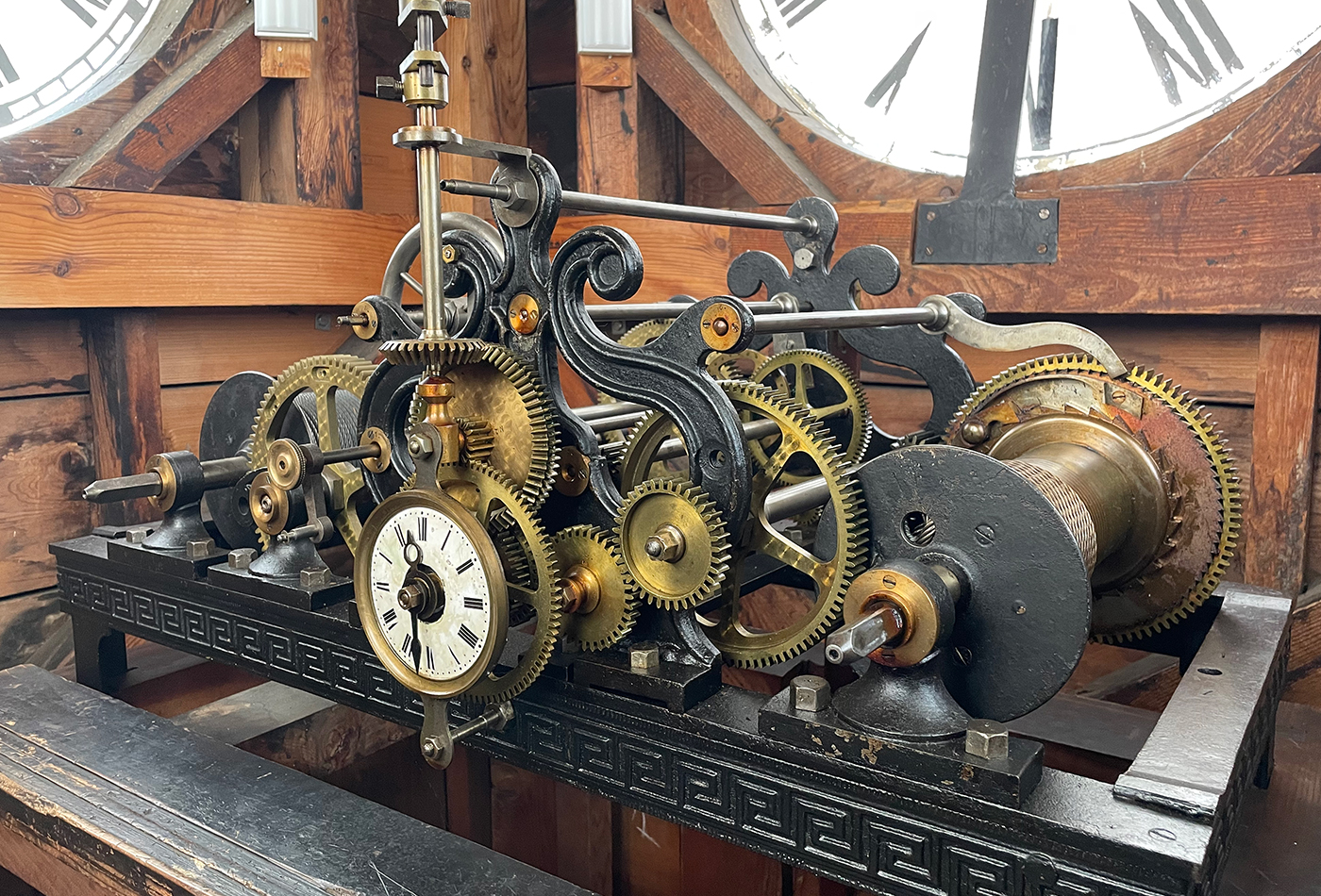
The space on the top floor, where only the sound of a clock is heard, gave me a special feeling as if I had come to another world.
A clock that has been running here for over 100 years.
I hope that the time will continue to be ticked from now on.
3. A must-see for Takeru Sato fans! Sanctuary of the movie Rurouni Kenshin
The Bunshokan is a building full of historical romance, so it feels like a great location for tv dramas and movies.
In fact, many scenes in the movies Rurouni Kenshin: Kyoto Inferno and Rurouni Kenshin: The Legend Ends were shot here!
_202206_49.jpg)
It was used as a building of the Ministry of Interior in Rurouni Kenshin: Kyoto Inferno where you can see the Bunshokan in many scenes at the beginning.
_202206_51.jpg)
The Old Governor’s Office is the setting for the scene where Kenshin Himura (Takeru Sato) meets Toshimichi Okubo (Kazufumi Miyazawa).
_202206_28.jpg)
The courtyard is also the place where Kenshin was captured and brought in Rurouni Kenshin: The Legend Ends released after Rurouni Kenshin: Kyoto Inferno.
_202206_23.jpg)
In the “Shokan”, an important scene is filmed in which Hirobumi Ito (Yukiyoshi Ozawa) and Hajime Saito (Yosuke Eguchi) meet and announce the battle with their nemesis.
_202206_18.jpg)
There was also an impressive scene where Kenshin got off the central staircase of Bunshokan and headed out in the light.
The movie scene is revived in my mind.
In addition, the scene where Kenshin meets Takano (actor Mashima from Yamagata Prefecture) for the first time was shot at Chitosekan near Bunshokan (old prefectural office).
* It was announced that the restaurant Chitosekan will be closed after 145 years at the end of September 2021 and will be maintained by Yamagata City as “Hanakoji Park (tentative name)”.
Rurouni Kenshin’s movies have been shot a lot on locations within Yamagata prefecture. The scene of the confrontation between Kenshin and Sojiro Seta (Ryunosuke Kamiki) was shot at the Studio Sedic Shonai Open Set located in Tsuruoka City.
I want to go there someday!
In addition, at Bunshokan, many works such as the movie Kakegurui – Compulsive Gambler and the popular Thai drama Dung Duang Haruetai were filmed there.
4. Enjoy sweets made with Yamagata fruits ♪
After taking a closer look at Bunshokan, why not immerse yourself in the lingering sound while eating sweets?
_202206_72.jpg)
This is the Yamagata Fruit café ~Hongmifull located in the Old Land Consolidation Drafting Room on the 2nd floor.
_202206_67.jpg)
This café, where you can see the old prefectural capitol from the window seat, just opened in August 2021.
The menu of the shop is lined with sweets using fruits from the fruit kingdom Yamagata.
_202206_71.jpg)
This time, I ordered the most recommended menu item, the Seasonal Fruit Croiffle.
_202206_69.jpg)
It looks delicious~! !! !!
It’s a dish with plenty of strawberries that makes it nice to see ♡
Of course, this strawberry and cherry confit is made from fruits from Yamagata prefecture.
What is a Croiffle? I found out that it is a sweet that is a combination of croissant and waffle.
The crispy texture, which is different from waffles, and the soft cream mixed in makes it irresistibly delicious!
_202206_73.jpg)
It seems that sweets and drinks using peaches and melons from Yamagata will be added to the menu depending on the season, so I will surely come again when the season changes.
There is also a rare table in the shop.
_202206_68.jpg)
On this table, a glass ball spins around on the sand under the glass top plate to draw a pattern.
The pattern seems to change depending on the program, so if you are interested, please check it out ♪
5. Summary
I’ve always thought that Bunshokan (old prefectural office) is a “nice building”, but this time I took a closer look at it while having the curator explain a lot to me. I feel like I became an expert on Bunshokan.
_202206_76.jpg)
When I stepped outside, I felt something strange about the usual scenery.
It feels like I’ve been on a short trip, even though I’ve only visited one building.
_202206_74.jpg)
_202206_78.jpg)
In addition, the site of the Bunshokan is large, and the front yard inside the gate has flowering trees and flower beds where you can enjoy the changing seasons.
_202206_75.jpg)
At the time of the interview, the weeping cherry blossoms were just beautiful and many people were holding their cameras.
_202206_80.jpg)
In Bunshokan, in addition to the ones introduced this time, there are four areas in Yamagata prefecture centered on the Mogami river, the “Corridor of the monument” where you can look back on people’s lives from the Meiji era.
There are many exhibits where you can learn about Yamagata Prefecture, such as “Mogami River Talks” that introduces the climate and culture of Murayama (Mogami, Shonai), and “Yamagata Literature” that introduces literature related to Yamagata Prefecture.
One of the reasons why Bunshokan is loved is that you can enjoy it differently depending on the interests of the viewer and the visitor.
_202206_77.jpg)
The more I know about it, the more attractive it is. Bunshokan is a valuable cultural heritage that Yamagata Prefecture is proud of.
Detailed information

-
Bunshokan (old prefectural office)
3-4-51 Hatagomachi, Yamagata City
023-635-5500023-635-5500

![[Feature] Pino Collina Matsugaoka! Winery & Restaurant in Shonai](https://www.visityamagata.jp/wp/wp-content/uploads/2024/06/pinocollina.jpg)
![[Feature] Sahato Benihana! Enjoy the starry sky at the prefecture’s largest planetarium](https://www.visityamagata.jp/wp/wp-content/uploads/2024/07/sahato.jpg)
![[Summary] Safflower Festival 2024! Discover Yamagata’s prefectural flower](https://www.visityamagata.jp/wp/wp-content/uploads/2021/06/紅花①.jpg)
![[Feature] Miraini! Sakata Activity Hub](https://www.visityamagata.jp/wp/wp-content/uploads/2024/02/compile-image_1707742235039.png)
![[Feature] Yukotto! Refreshing time in hot springs](https://www.visityamagata.jp/wp/wp-content/uploads/2024/03/yukotto.jpg)